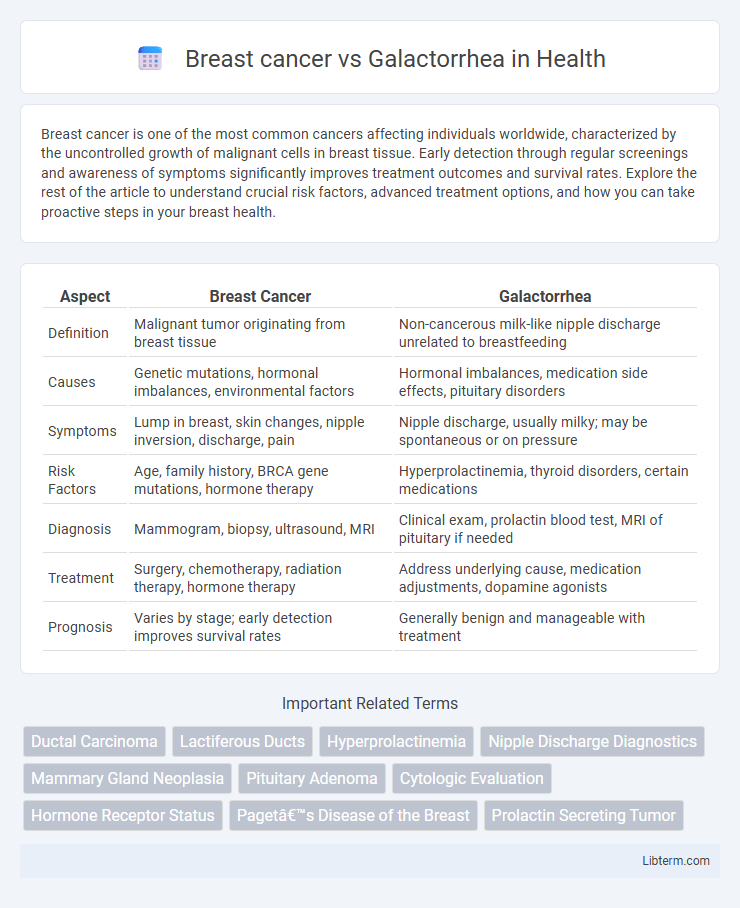Breast cancer is one of the most common cancers affecting individuals worldwide, characterized by the uncontrolled growth of malignant cells in breast tissue. Early detection through regular screenings and awareness of symptoms significantly improves treatment outcomes and survival rates. Explore the rest of the article to understand crucial risk factors, advanced treatment options, and how you can take proactive steps in your breast health.
Table of Comparison
| Aspect | Breast Cancer | Galactorrhea |
|---|---|---|
| Definition | Malignant tumor originating from breast tissue | Non-cancerous milk-like nipple discharge unrelated to breastfeeding |
| Causes | Genetic mutations, hormonal imbalances, environmental factors | Hormonal imbalances, medication side effects, pituitary disorders |
| Symptoms | Lump in breast, skin changes, nipple inversion, discharge, pain | Nipple discharge, usually milky; may be spontaneous or on pressure |
| Risk Factors | Age, family history, BRCA gene mutations, hormone therapy | Hyperprolactinemia, thyroid disorders, certain medications |
| Diagnosis | Mammogram, biopsy, ultrasound, MRI | Clinical exam, prolactin blood test, MRI of pituitary if needed |
| Treatment | Surgery, chemotherapy, radiation therapy, hormone therapy | Address underlying cause, medication adjustments, dopamine agonists |
| Prognosis | Varies by stage; early detection improves survival rates | Generally benign and manageable with treatment |
Introduction to Breast Cancer and Galactorrhea
Breast cancer is a malignant tumor originating from breast cells, often characterized by uncontrolled cell growth forming lumps or masses, frequently detected through mammography and biopsy. Galactorrhea refers to an abnormal, non-puerperal lactation or milk discharge from the breast, commonly linked to hormonal imbalances, particularly elevated prolactin levels. Understanding the distinct etiologies and clinical presentations of breast cancer and galactorrhea is essential for differential diagnosis and effective patient management.
Understanding Breast Cancer: Causes and Risk Factors
Breast cancer originates from the uncontrolled growth of abnormal cells in breast tissue, often linked to genetic mutations such as BRCA1 and BRCA2. Key risk factors include age, family history, hormonal imbalances, exposure to radiation, and lifestyle choices like alcohol consumption and obesity. Differentiating breast cancer from galactorrhea, which involves non-cancerous milk secretion often caused by hormonal disturbances or medications, is crucial for accurate diagnosis and treatment.
Galactorrhea: Definition and Common Causes
Galactorrhea is the spontaneous flow of milk from the breast unrelated to childbirth or nursing, often caused by hormonal imbalances such as elevated prolactin levels. Common causes include pituitary adenomas, hypothyroidism, certain medications like antipsychotics and antidepressants, and chronic kidney disease. Distinguishing galactorrhea from breast cancer is critical, as galactorrhea typically presents without a palpable mass or skin changes associated with malignancy.
Key Differences: Symptoms of Breast Cancer vs Galactorrhea
Breast cancer symptoms often include a palpable lump, nipple retraction, skin dimpling, and unexplained nipple discharge, usually bloody or clear, whereas galactorrhea primarily presents as spontaneous, milky nipple discharge unrelated to breastfeeding. Pain is less common in early breast cancer but may accompany galactorrhea due to hormonal imbalances or medication effects. Unlike breast cancer, galactorrhea is typically bilateral and associated with endocrine disorders such as hyperprolactinemia.
Diagnostic Approaches for Breast Cancer and Galactorrhea
Diagnostic approaches for breast cancer primarily include mammography, ultrasound, and MRI to detect tumors and abnormalities in breast tissue, complemented by biopsy for histopathological confirmation. In contrast, galactorrhea diagnosis involves hormonal evaluation with serum prolactin levels, thyroid function tests, and imaging studies such as pituitary MRI to identify underlying endocrine disorders. Both conditions require careful clinical examination and tailored diagnostic protocols to ensure accurate detection and appropriate management.
Hormonal Influences in Both Conditions
Breast cancer and galactorrhea are both influenced by hormonal imbalances, particularly involving estrogen, progesterone, and prolactin. In breast cancer, elevated estrogen and progesterone levels can promote tumor growth by stimulating hormone receptor-positive cancer cells. Galactorrhea primarily results from hyperprolactinemia, where excessive prolactin secretion disrupts normal breast function, leading to abnormal milk production independent of pregnancy or breastfeeding.
Treatment Options: Breast Cancer vs Galactorrhea
Breast cancer treatment options include surgery, radiation therapy, chemotherapy, hormone therapy, and targeted therapy tailored to tumor type and stage. Galactorrhea management typically involves addressing underlying causes such as hyperprolactinemia with dopamine agonists like bromocriptine or cabergoline, and adjusting medications that may trigger symptoms. Precise diagnosis guides effective treatment, distinguishing malignant breast tumors from benign prolactin-induced nipple discharge.
When to Seek Medical Attention
Persistent breast lumps, nipple discharge, or changes in breast shape can indicate breast cancer and require immediate medical evaluation. Galactorrhea, characterized by unexpected milk secretion without childbirth or nursing, should prompt consultation when accompanied by other symptoms like menstrual irregularities, headaches, or visual disturbances. Early diagnosis through clinical exams, imaging, and hormonal tests is crucial for effective treatment and better outcomes.
Preventive Strategies for Breast Health
Regular breast cancer screening through mammograms and self-examinations enables early detection and significantly improves treatment outcomes. Maintaining hormonal balance by managing stress and avoiding medications that increase prolactin levels helps prevent galactorrhea. A diet rich in antioxidants, regular exercise, and limiting alcohol intake contribute to overall breast health and reduce risks associated with both conditions.
Living with and Managing Breast Conditions
Living with breast cancer involves regular monitoring, targeted treatments such as chemotherapy or radiation, and supportive care to manage symptoms and side effects. Managing galactorrhea centers on identifying underlying causes like hormonal imbalances or medication side effects, often requiring endocrinological evaluation and tailored therapies to reduce milk production. Both conditions necessitate lifestyle adjustments, psychological support, and close collaboration with healthcare providers to maintain breast health and overall well-being.
Breast cancer Infographic

 libterm.com
libterm.com